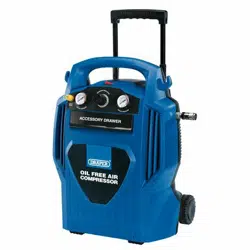Loading ...
Loading ...
Loading ...

5. HEALTH & SAFETY INFORMATION
13
8
Check that the discharge flow rate of the valve is greater than the quantity of the air to discharge.
The safety valve must be positioned directly on the tank in a vertical position, in a dry, accessible
place protected against the weather and far away from liquids or condensation.
It must be positioned so as to have sufficient space all around for correct air discharge, without
causing damage to persons and/or things. The valve rod must therefore be free in its movement
when discharging.
The connection between the valve and the part to be protected must be free from all kinds of
choking and be as short as possible so as not to reduce the discharge flow rate of the valve itself.
The connection passage area must be greater than the valve orifice area. During installation,
screw on the valve with a torque spanner using the hexagonal part of the body. Apply a maximum
torque of 30Nm, paying attention not to cause any deformation; using pincers, pliers, hammers or
tools other than a hexagonal spanner is forbidden. Check the inlet hole and the shutter are not
blocked by glue, Teflon or similar materials that could bind the shutter or other functional
components. If the valve is replaced, the compressor air contained in the system must be
discharged first. We decline all responsibility for damage caused to persons and/or things due to
failure to observe these instructions.
Maintenance and inspection: The valve must not be subject to knocks which may cause
deformities. It is obligatory for qualified technicians to make sure that the safety valve functions
correctly at least once a year. Valves equipped with a ring must be tested while pressurised to
between 80 – 90% of the calibration value. Pull the ring and release immediately. During the test
the valve must definitely open and discharge the air and re-close immediately when the ring is
released. It is absolutely necessary to carry out this procedure with the utmost caution because
this type of job can be dangerous if adequate safety measures are not taken; wear goggles, a
head set and anything else necessary to protect against noise, jets of air, etc. which may be
discharged from the valve.
5.3 ADDITIONAL SAFETY INSTRUCTIONS FOR PRESSURE VESSELS
• This pressure tank is mainly intended for static use. It can only be charged with natural air
within temperature and pressure limits as specified on the manufacturer's plate and
declaration of conformity.
• Ensure that tank safety and control devices are efficient and flawless. When replaced, the tank
should not be under pressure.
• Drain the condensation off the tank every day.
• Check for signs of inner corrosion at regular intervals. Tank walls should have a minimum
thickness of 1.0 – 2.0mm.
• Any kind of welding to the tank is forbidden.
• The user shall comply with laws on pressure vessel operation in force in the country in which
the tank is operated.
• The construction is mainly effected for permanent load by internal pressure. Cyclic loads are
not considered, only for a range of 10% PS.
9. OPERATION
9.1 BASIC COMPRESSOR OPERATION
– FIG. 3
1. Connect the air line to the compressor by
pulling back the collar
on the air outlet
quick coupling
and inserting the
corresponding air coupling fitted on the air line.
Release the collar so it slides back in place to
secure the air coupling.
2. Turn the air regulator
clockwise to its
lowest setting and turn on the compressor.
3. Once the compressor has reached maximum
pressure, open the regulator valve
to the
desired pressure on the tank pressure gauge
.
9.2 MOISTURE IN COMPRESSED AIR
Moisture in compressed air will form into droplets as it comes from an air compressor
pump. When humidity is high or when a compressor is in continuous use for an extended
period of time, this moisture will collect in the tank. When using a paint spray gun or
sandblast gun, this water will be carried from the tank through the hose, and out of the gun
as droplets mixed with the spray material.
IMPORTANT: This condensation will cause water spots in a paint job, especially when
spraying other than water based paints. If sandblasting, it will cause the sand to case and
clog the gun rendering it ineffective. A filter in the air line, located as near to the gun as
possible, will help eliminate this moisture.
9.3 SAFETY VALVE – FIG. 4
WARNING: DO NOT REMOVE OR ATTEMPT TO
ADJUST THE SAFETY VALVE!
This valve
should be checked under pressure
occasionally by pulling the ring
by hand. If air
leaks after the ring has been released, or valve is
stuck, it MUST be replaced.
FIG. 3
FIG. 4
Loading ...
Loading ...
Loading ...
